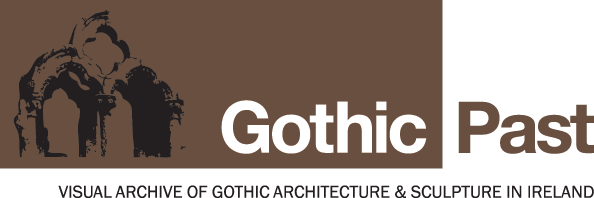Browse Items (529 total)
Sort by Title [A-Z] | [Z-A]
Clontuskert Augustinian Priory, west door, jamb and arch
West door moulding, from soffit moulding comprises: roll-and-fillet, fillet, hollow, fillet, roll-and-fillet, fillet, hollow, fillet, roll-and-fillet, fillet, hollow, roll-and-fillet, fillet, pinnacle. This door, in its overall composition and the width of the fillets, is close to doors at Holycross, Kilcooly and other works related to them.
Clontuskert Augustinian Priory, rood screen, base
Base of rood screen, moulding comprises from top down: chamfered fillet, bell with keel, scroll, ogee, chamfer, plinth. This is similar to the complex bases from the cloister at Holycross, similar also to those at Lorrah Dominican and Roscrea.
Claregalway Franciscan Friary, north chancel wall, tomb niche, hood
Hood moulding of tomb niche, from outer to inner surface moulding comprises: chamfer, roll.
Claregalway Franciscan Friary, north chancel wall, tomb niche, arch
Tomb niche in north nave wall. Moulding at inner surface has cusps, and from these outward comprises: fillet, three-quarter hollow, fillet, quadrant, fillet, chamfer (can be read as roll with two fillets), chamfer, right-angled rebate, quadrant, fillet, three-quarter hollow, fillet, quadrant, fillet, chamfer (can be read as roll with two fillets),…
Athenry Dominican Priory, south nave wall, niche, arch and hood
Arch and hood moulding of eastern niche in south nave wall. Moulding of arch from inner to outer face comprises: hollow, roll-and-fillet, flat surface, roll-and-fillet, right-angled rebate, flat surface of wall. From outer to inner face, hood comprises: frontal fillet, hollow, hollow, quarter roll, hollow.
Athenry Dominican Priory, south nave wall, niche, base
A capital reused as a base. If read as a capital moulding comprises: roll-and-fillet, roll, dogtooth, roll, bell, necking roll.
Athenry Dominican Priory, south nave wall, niche, capital
Capital of middle niche/sedilia of south nave wall, moulding from top down comprises: chamfer, fillet, hollow, stiff-leaf foliage, bell, necking roll-and-fillet. Here again Early English characteristics are manifest but the niche may date from the later middle ages.
Athenry Dominican Priory, south nave wall, niche, arch and hood
Arch and hood moulding of westernmost niche of south nave wall. Arch moulding from inner surface comprises: chamfer, flat surface, hollow, roll-and-fillet, roll, hollow, chamfer, flat surface of wall. The hood, from outside face to inner comprises: roll-and-fillet, hollow, chamfer. The style of this moulding can best be described as debased Early…
Athenry Dominican Priory, south nave wall, niche, capital
Capital of niche, mouliding comprises from top down: roll-and-fillet, fillet, hollow, quadrant, fillet, hollow, roll with lower fillet, bell. The necking roll is missing.
St. Mary's Collegiate Church, Youghal, north choir wall, tomb niche, base of pinnacle
Base of pinnacle flanking tomb nice. Moulding from top down comprises: roll, bell, roll, roll, bell, fillet, sloping plinth. This base is Perpendicular in form and compares with those at Sligo Dominican, Strade and Ballintubber.
St. Mary's Collegiate Church, Youghal, north choir wall, tomb niche, base of niche
Base of tomb niche opening, moulding from top down comprises: roll, roll, bell, roll, roll, bell, curved plinth. Very unusual Perpendicular style base, other examples can be found at Strade, Sligo Dominican, Balintubber.
Rathbourney church, east window, mullion
Twin ogee headed window under square label, moulding of mullion comprises: frontal fillet flanked at either side by quadrant, right-angled rebate, hollow chamfer. The rear of the mullion is rectangular.
Rathbourney church, east window, jamb
Twin ogee headed lights under a square label. Jamb moulding comprises, from intrados: hollow chamfer, right-angled rebate, quadrant, right-angled rebate, ogee.
Rathbourney church, south window, jamb
Jamb of ogee headed light under square label. From intrados the moulding comprises: hollow chamfer, right-angled rebate, quadrant, right-angled rebate, ogee.
Rathbourney church, south door, jamb, arch and hood moulding
Door jamb and arch moulding comprises, from intrados: hollow chamfer, hollow chamfer, right-angled rebate, quadrant, quadrant. The hood comprises, from outward in: frontal fillet, frontal fillet, hollow chamfer.
Kilmacreehy church, east window, hood
Square label of ogee headed light. From the outside inward the moulding comprises: frontal fillet, hollow chamfer, quadrant, hollow chamfer.
Kilmacreehy church, north chancel wall, tomb niche, jamb
Jamb moulding of tomb, moulding comprises: corner roll flanked at either side by angle fillets and a chamfer.
Kilmacreehy church, south chancel wall, tomb niche, jamb
Jamb of reconstructed tomb niche. Moulding comprises corner roll, flanked at either side by fillet and hollow. Looks twelfth- or thirteenth-century but may be revival of these forms from the fifteenth century.
Quin Franciscan Friary, south chancel wall, tomb niche, jamb, arch and hood
Moulding of jamb, arch and hood. From intrados, moulding comprises: hollow chamfer, quadrant, hollow chamfer. The hood comprises: ogee, hollow chamfer, with a frontal fillet. This tomb niche is similar to examples at Ennis, Adare Franciscan, Adare Augustinian, Askeaton, Lislaughtin, Abbeydorney and Kilconnell.
Quin Franciscan Friary, chancel, MacNamara tomb, bracket
Bracket of pinnacle, with moulding comprising: free-standing fillet, free-standing fillet, free-standing fillet.




















